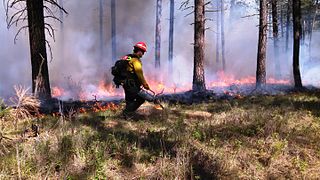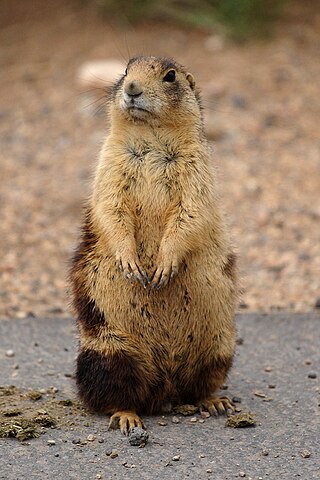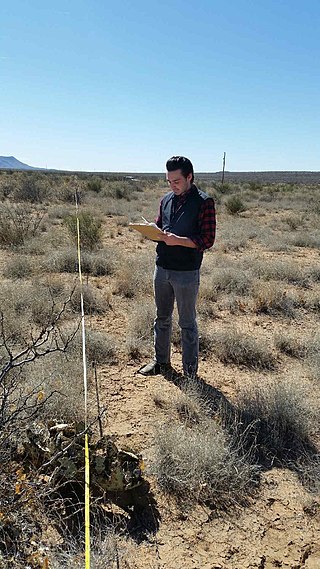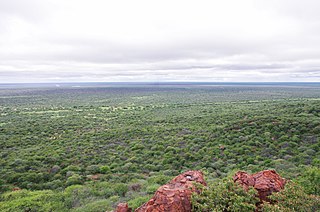
Bromus tectorum, known as downy brome, drooping brome or cheatgrass, is a winter annual grass native to Europe, southwestern Asia, and northern Africa, but has become invasive in many other areas. It now is present in most of Europe, southern Russia, Japan, South Africa, Australia, New Zealand, Iceland, Greenland, North America and western Central Asia. In the eastern US B. tectorum is common along roadsides and as a crop weed, but usually does not dominate an ecosystem. It has become a dominant species in the Intermountain West and parts of Canada, and displays especially invasive behavior in the sagebrush steppe ecosystems where it has been listed as noxious weed. B. tectorum often enters the site in an area that has been disturbed, and then quickly expands into the surrounding area through its rapid growth and prolific seed production.

A controlled or prescribed (Rx) burn is the practice of intentionally setting a fire to change the assemblage of vegetation and decaying material in a landscape. The purpose could be for forest management, ecological restoration, land clearing or wildfire fuel management. A controlled burn may also refer to the intentional burning of slash and fuels through burn piles. Controlled burns may also be referred to as hazard reduction burning, backfire, swailing or a burn-off. In industrialized countries, controlled burning regulations and permits are usually overseen by fire control authorities.

Rangelands are grasslands, shrublands, woodlands, wetlands, and deserts that are grazed by domestic livestock or wild animals. Types of rangelands include tallgrass and shortgrass prairies, desert grasslands and shrublands, woodlands, savannas, chaparrals, steppes, and tundras. Rangelands do not include forests lacking grazable understory vegetation, barren desert, farmland, or land covered by solid rock, concrete, or glaciers.

An oak savanna is a type of savanna, where oaks are the dominant trees. It is also generally characterized by an understory that is lush with grass and herb related plants. The terms "oakery" or "woodlands" are also used commonly, though the former is more prevalent when referencing the Mediterranean area. Oak savannas typically exist in areas with low precipitation and feature poor soils. Predominant land uses include rangeland agriculture. Naturally, these savannas depend on natural wildfires to maintain their open vegetation.
Michael L. Rosenzweig is a professor of ecology and evolutionary biology at the University of Arizona. He developed and popularized the concept of reconciliation ecology. He received his Ph.D in zoology at the University of Pennsylvania in 1966 and has held a number of academic positions around the United States.

Biological soil crusts are communities of living organisms on the soil surface in arid and semi-arid ecosystems. They are found throughout the world with varying species composition and cover depending on topography, soil characteristics, climate, plant community, microhabitats, and disturbance regimes. Biological soil crusts perform important ecological roles including carbon fixation, nitrogen fixation and soil stabilization; they alter soil albedo and water relations and affect germination and nutrient levels in vascular plants. They can be damaged by fire, recreational activity, grazing and other disturbances and can require long time periods to recover composition and function. Biological soil crusts are also known as biocrusts or as cryptogamic, microbiotic, microphytic, or cryptobiotic soils.

The Utah prairie dog is the smallest species of prairie dog endemic to the south-central steppes of the American state of Utah.
Simon Asher Levin is an American ecologist and the James S. McDonnell Distinguished University Professor in Ecology and Evolutionary Biology and the director of the Center for BioComplexity at Princeton University. He specializes in using mathematical modeling and empirical studies in the understanding of macroscopic patterns of ecosystems and biological diversities.

In ecology, a mesic habitat is a type of habitat with a well-balanced or moderate supply of moisture throughout the growing season. The term derives from the Greek mesos, meaning middle, indicating its relative moisture content between hydric (moist) and xeric (dry) habitats. The word "mesic" can apply to the plants or soils within the mesic habitat.
John Philip Grime was an ecologist and emeritus professor at the University of Sheffield. He is best known for the universal adaptive strategy theory (UAST) and the twin filter model of community assembly with Simon Pierce, eco-evolutionary dynamics, the unimodal relationship between species richness and site productivity, the intermediate disturbance hypothesis, and DST classification.
Deep ecology is an environmental philosophy that promotes the inherent worth of all living beings regardless of their instrumental utility to human needs, and argues that modern human societies should be restructured in accordance with such ideas.
Michael Mortimore was a British geographer and a prolific researcher of issues in the African drylands. He was an academic in Nigerian universities for over 25 years. He ran a British research consultancy, Drylands Research. He is best known for an anti-Malthusian account of population-environment relationships, More People, Less Erosion, and field-based studies of adaptation to drought.

Rangeland management is a natural science that centers around the study of rangelands and the "conservation and sustainable management [of Arid-Lands] for the benefit of current societies and future generations". Range management is defined by Holechek et al. as the "manipulation of rangeland components to obtain optimum combination of goods and services for society on a sustained basis". The United Nations (UN) has declared 2026 the International Year of Rangelands and Pastoralists, with the Food and Agriculture Organization leading the initiative.

Diana Harrison Wall was an American environmental scientist and soil ecologist. She was the founding director of the School of Global Environmental Sustainability, a distinguished biology professor, and senior research scientist at the Natural Resource Ecology Laboratory at Colorado State University. Wall investigated ecosystem processes, soil biodiversity and ecosystem services. Her research focused on the Antarctic McMurdo Dry Valleys and its Wall Valley was named after her. Wall was a globally recognized leader and speaker on life in Antarctica and climate change.

Woody plant encroachment is a natural phenomenon characterised by the area expansion and density increase of woody plants, bushes and shrubs, at the expense of the herbaceous layer, grasses and forbs. It refers to the expansion of native plants and not the spread of alien invasive species. Woody encroachment is observed across different ecosystems and with different characteristics and intensities globally. It predominantly occurs in grasslands, savannas and woodlands and can cause regime shifts from open grasslands and savannas to closed woodlands.

Osvaldo Sala is an ecologist and educator at Arizona State University, where he is the Julie A. Wrigley, Regents and Foundation Professor and the Founding Director of the Global Drylands Center, as well as founder of the Sala Lab. He is known for his research on how global change affects the functioning of global ecosystems and their biodiversity, with a focus on drylands.
Tadashi Fukami is an associate Professor of Biology and community ecologist at Stanford University. He is currently the head of Fukami Lab which is a community ecology research group that focuses on "historical contingency in the assembly of ecological communities." Fukami is an elected Fellow of the Ecological Society of America.

Roger Dale Rosentreter is a botanist, plant ecologist, naturalist, and conservationist. He was the president of the American Bryological and Lichenological Society from 2011 to 2013.
Mark Westoby is an Australian evolutionary ecologist, emeritus professor at Macquarie University, and a specialist in trait ecology.

Wild by Design: The Rise of Ecological Restoration is a 2022 book by Laura J. Martin, Associate Professor of Environmental Studies at Williams College. The book explains how ecological restoration became a global pursuit. Martin defines restoration as "an attempt to co-design nature with non-human collaborators." Wild by Design calls for the unification of ecological restoration and social justice.













